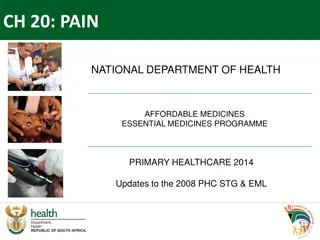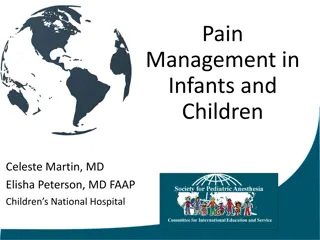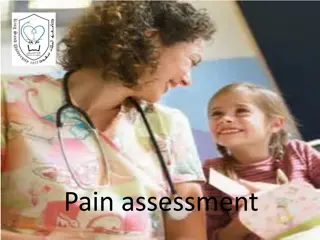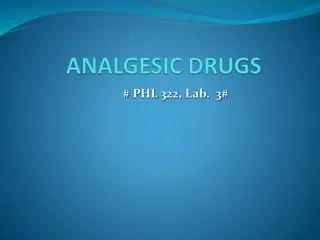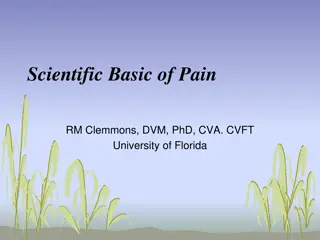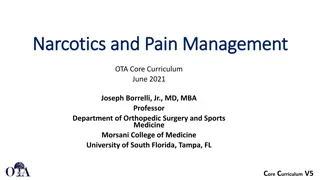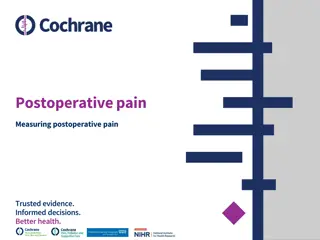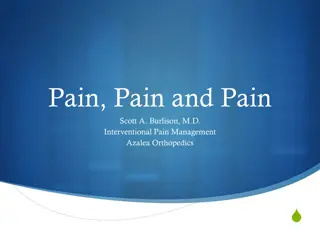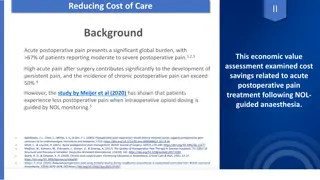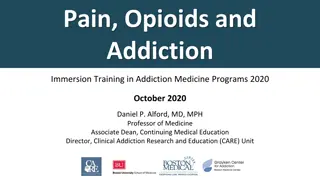Understanding Pain: Mechanisms and Pathways
This content delves into the intricate mechanisms of pain perception, exploring the anterolateral system, nociceptors, endogenous analgesic systems, and more. It covers topics such as free nerve endings, VR1/Capsaicin receptors, referred pain, neuropathic pain, hyperalgesia, and visceral pain. The material also examines different pain types, their characteristics, and the pathways involved in pain transmission and modulation.
Download Presentation

Please find below an Image/Link to download the presentation.
The content on the website is provided AS IS for your information and personal use only. It may not be sold, licensed, or shared on other websites without obtaining consent from the author. Download presentation by click this link. If you encounter any issues during the download, it is possible that the publisher has removed the file from their server.
E N D
Presentation Transcript
Pain Anterolateral system
Free Nerve Endings Warm (30-45) Cold (10-40) noci TRP- Transient Receptor Potential (VR- Vanilloid receptor ) ASIC (acid sensing ion channel)
Endogenous analgesic system Gate control Descending control
Nociceptors A. are activated by strong pressure, severe cold, severe heat, and chemicals. B. are absent in visceral organs. C. are specialized structures located in the skin and joints. D. are innervated by group II afferents. E. are involved in acute but not chronic pain.
Which of the following are correctly paired? A. Neuropathic pain and withdrawal reflex B. First pain (fast pain) and dull, intense, diffuse, and unpleasant feeling C. Physiological pain and allodynia D. Second pain (slow pain) and C fibers E. Nociceptive pain and nerve damage
Hyperalgesia Allodynia Neuropathic pain
A 32-year-old female experienced the sudden onset of a severe cramping pain in the abdominal region. She also became nauseated. Visceral pain A. shows relatively rapid adaptation. B. is mediated by B fibers in the dorsal roots of the spinal nerves. C. is poorly localized. D. resembles fast pain produced by noxious stimulation of the skin. E. causes relaxation of nearby skeletal muscles.
A ventrolateral cordotomy is performed that produces relief of pain in the right leg. It is effective because it interrupts the A. left dorsal column. B. left ventrolateral spinothalamic tract. C. right ventrolateral spinothalamic tract. D. right medial lemniscal pathway. E. a direct projection to the primary somatosensory cortex.
A 50-year-old woman undergoes a neurological exam that indicates loss of pain and temperature sensitivity, vibratory sense, and proprioception in the left leg. These symptoms could be explained by A. a tumor on the right medial lemniscal pathway in the sacral spinal cord. B. a peripheral neuropathy. C. a tumor on the left medial lemniscal pathway in the sacral spinal cord. D. a tumor affecting the right posterior paracentral gyrus. E. a large tumor in the right lumbar ventrolateral spinal cord.
A 40-year-old man loses his right hand in a farm accident. Four years later, he has episodes of severe pain in the missing hand (phantom limb pain). A detailed PET scan study of his cerebral cortex might be expected to show A. expansion of the right hand area in his right primary somatosensory cortex. B. expansion of the right-hand area in his left primary somatosensory cortex. C. a metabolically inactive spot where his hand area in his left primary somatosensory cortex would normally be. D. projection of fibers from neighboring sensory areas into the right-hand area of his right primary somatosensory cortex. E. projection of fibers from neighboring sensory areas into the right-hand area of his left primary somatosensory cortex.











